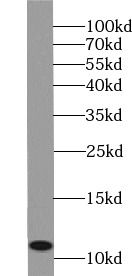Products
S100B antibody
Category:
Research Area:
| Synonyms: | NEF antibody, Protein S100 B antibody, S 100 protein beta chain antibody, S 100 protein subunit beta antibody, S100 antibody, S100 calcium binding protein B antibody, S100B antibody, S100beta antibody | ||
| Catalogue No.: | FNab07566 | Reactivity: | Human, Mouse, Rat |
| Host: | Rabbit | Tested Application: | ELISA, WB, IHC, IF |
| Clonality: | polyclonal | Isotype: | IgG |
- SPECIFICATIONS
- Product Name
- S100B antibody
- Catalogue No.
- FNab07566
- Size
- 100μg
- Form
- liquid
- Purification
- Immunogen affinity purified
- Purity
- ≥95% as determined by SDS-PAGE
- Clonality
- polyclonal
- Isotype
- IgG
- Storage
- PBS with 0.02% sodium azide and 50% glycerol pH 7.3, -20℃ for 12 months(Avoid repeated freeze / thaw cycles.)
Immunogen
- Immunogen
- S100 calcium binding protein B
- Alternative Names
- NEF antibody, Protein S100 B antibody, S 100 protein beta chain antibody, S 100 protein subunit beta antibody, S100 antibody, S100 calcium binding protein B antibody, S100B antibody, S100beta antibody
- UniProt ID
- P04271
- Observed MW
- 11KD
Application
- Tested Applications
- ELISA, WB, IHC, IF
- Recommended dilution
- WB: 1:200-1:1000; IHC: 1:50-1:500; IF: 1:50-1:500
Validated Images
 A375 cells were subjected to SDS PAGE followed by western blot with FNab07566(S100B antibody) at dilution of 1:400
A375 cells were subjected to SDS PAGE followed by western blot with FNab07566(S100B antibody) at dilution of 1:400
 Immunohistochemistry of paraffin-embedded human breast cancer slide using FNab07566(S100 Antibody) at dilution of 1:200
Immunohistochemistry of paraffin-embedded human breast cancer slide using FNab07566(S100 Antibody) at dilution of 1:200
- Background
- Weakly binds calcium but binds zinc very tightly-distinct binding sites with different affinities exist for both ions on each monomer. Physiological concentrations of potassium ion antagonize the binding of both divalent cations, especially affecting high-affinity calcium-binding sites. Binds to and initiates the activation of STK38 by releasing autoinhibitory intramolecular interactions within the kinase. Interaction with AGER after myocardial infarction may play a role in myocyte apoptosis by activating ERK1/2 and p53/TP53 signaling. Could assist ATAD3A cytoplasmic processing, preventing aggregation and favoring mitochondrial localization. May mediate calcium-dependent regulation on many physiological processes by interacting with other proteins, such as TPR-containing proteins, and modulating their activity.



